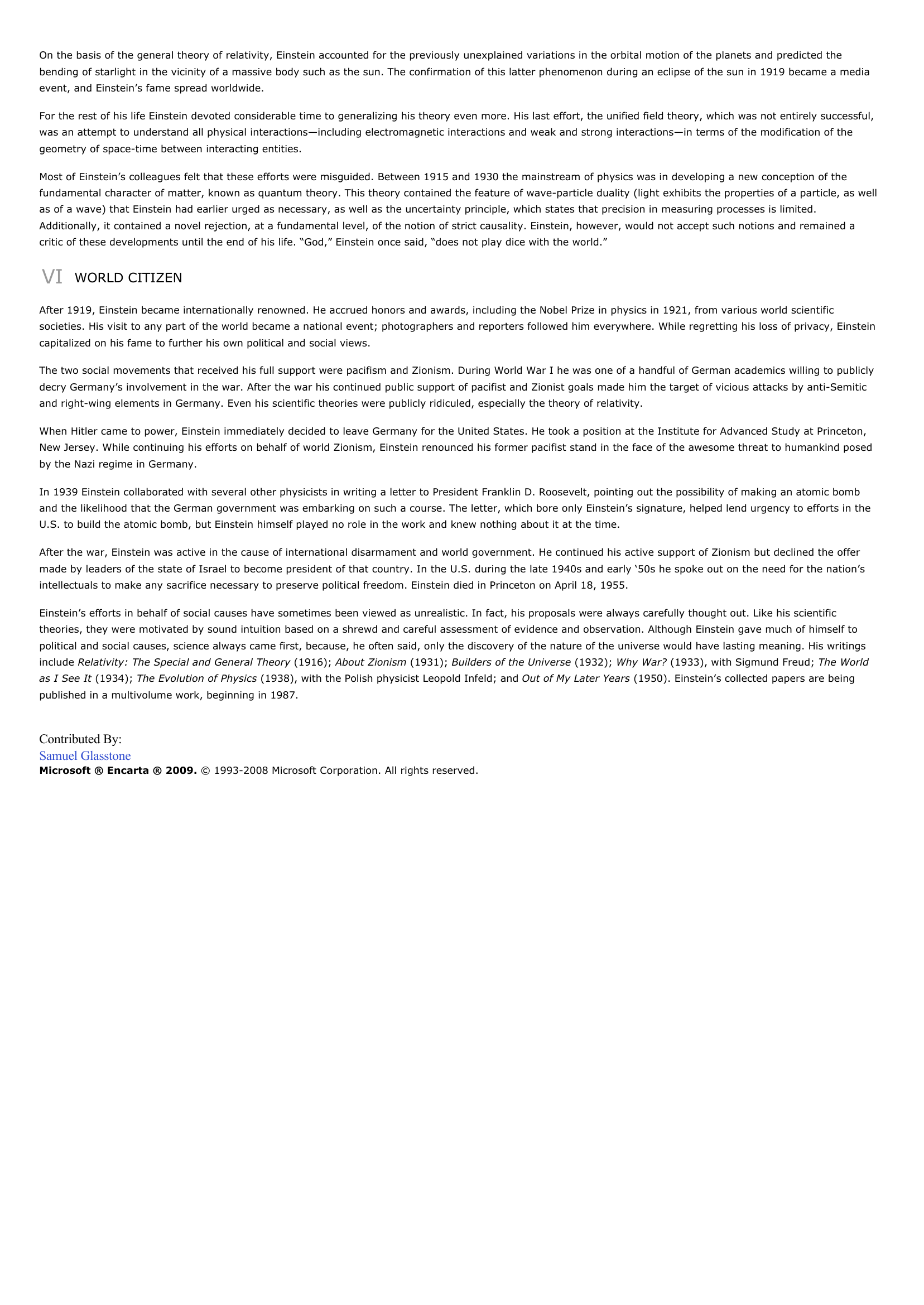Albert Einstein.
Publié le 03/05/2013
Extrait du document


«
On the basis of the general theory of relativity, Einstein accounted for the previously unexplained variations in the orbital motion of the planets and predicted thebending of starlight in the vicinity of a massive body such as the sun.
The confirmation of this latter phenomenon during an eclipse of the sun in 1919 became a mediaevent, and Einstein’s fame spread worldwide.
For the rest of his life Einstein devoted considerable time to generalizing his theory even more.
His last effort, the unified field theory, which was not entirely successful,was an attempt to understand all physical interactions—including electromagnetic interactions and weak and strong interactions—in terms of the modification of thegeometry of space-time between interacting entities.
Most of Einstein’s colleagues felt that these efforts were misguided.
Between 1915 and 1930 the mainstream of physics was in developing a new conception of thefundamental character of matter, known as quantum theory.
This theory contained the feature of wave-particle duality (light exhibits the properties of a particle, as wellas of a wave) that Einstein had earlier urged as necessary, as well as the uncertainty principle, which states that precision in measuring processes is limited.Additionally, it contained a novel rejection, at a fundamental level, of the notion of strict causality.
Einstein, however, would not accept such notions and remained acritic of these developments until the end of his life.
“God,” Einstein once said, “does not play dice with the world.”
VI WORLD CITIZEN
After 1919, Einstein became internationally renowned.
He accrued honors and awards, including the Nobel Prize in physics in 1921, from various world scientificsocieties.
His visit to any part of the world became a national event; photographers and reporters followed him everywhere.
While regretting his loss of privacy, Einsteincapitalized on his fame to further his own political and social views.
The two social movements that received his full support were pacifism and Zionism.
During World War I he was one of a handful of German academics willing to publiclydecry Germany’s involvement in the war.
After the war his continued public support of pacifist and Zionist goals made him the target of vicious attacks by anti-Semiticand right-wing elements in Germany.
Even his scientific theories were publicly ridiculed, especially the theory of relativity.
When Hitler came to power, Einstein immediately decided to leave Germany for the United States.
He took a position at the Institute for Advanced Study at Princeton,New Jersey.
While continuing his efforts on behalf of world Zionism, Einstein renounced his former pacifist stand in the face of the awesome threat to humankind posedby the Nazi regime in Germany.
In 1939 Einstein collaborated with several other physicists in writing a letter to President Franklin D.
Roosevelt, pointing out the possibility of making an atomic bomband the likelihood that the German government was embarking on such a course.
The letter, which bore only Einstein’s signature, helped lend urgency to efforts in theU.S.
to build the atomic bomb, but Einstein himself played no role in the work and knew nothing about it at the time.
After the war, Einstein was active in the cause of international disarmament and world government.
He continued his active support of Zionism but declined the offermade by leaders of the state of Israel to become president of that country.
In the U.S.
during the late 1940s and early ‘50s he spoke out on the need for the nation’sintellectuals to make any sacrifice necessary to preserve political freedom.
Einstein died in Princeton on April 18, 1955.
Einstein’s efforts in behalf of social causes have sometimes been viewed as unrealistic.
In fact, his proposals were always carefully thought out.
Like his scientifictheories, they were motivated by sound intuition based on a shrewd and careful assessment of evidence and observation.
Although Einstein gave much of himself topolitical and social causes, science always came first, because, he often said, only the discovery of the nature of the universe would have lasting meaning.
His writingsinclude Relativity: The Special and General Theory (1916); About Zionism (1931); Builders of the Universe (1932); Why War? (1933), with Sigmund Freud; The World as I See It (1934); The Evolution of Physics (1938), with the Polish physicist Leopold Infeld; and Out of My Later Years (1950).
Einstein’s collected papers are being published in a multivolume work, beginning in 1987.
Contributed By:Samuel GlasstoneMicrosoft ® Encarta ® 2009. © 1993-2008 Microsoft Corporation.
All rights reserved..
»
↓↓↓ APERÇU DU DOCUMENT ↓↓↓
Liens utiles
- COMMENT JE VOIS LE MONDE, Albert Einstein (résumé)
- Le problème du rapport théorie-expérience - Albert Einstein
- Albert Einstein par Louis de Broglie de l'Académie française et de l'Académie des Sciences.
- Allemand d'origine, Albert Einstein changea deux fois de nationalité.
- Albert Einstein - ciencia y tecnologia.

































